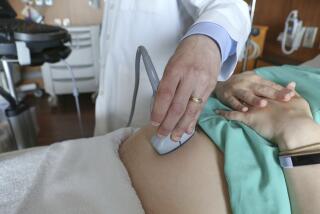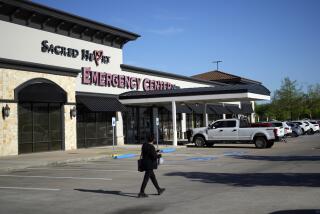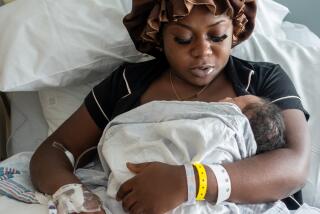Trends : HOSPITAL SEES GOLD IN BABIES : Saddleback Ties Future to Women’s Health Care
- Share via
When Saddleback Hospital and Health Center opened in January, 1974, its obstetrics service was an immediate flop.
The hospital was built primarily to serve the adjacent Leisure World Laguna Hills community of senior citizens and just didn’t admit many women who were having babies. After four months, the obstetrics department closed. Later the space was converted to a coronary care unit.
But today, Saddleback Hospital is taking a new run at obstetrics, this time with a splash. Not only is it establishing a state-of-the-art maternity department--the first in the county where an expectant mother can go through labor, delivery, recovery and postpartum in a private room with hotel-like comforts--but it is building a separate, 33-bed women’s hospital with its own staff of physicians. The facility will be next to the 178-bed general hospital.
And this time, the hospital expects no shortage of expectant mothers because of the explosion of planned communities in south Orange County, which are filling up with young families.
Competition and Opportunity
Hospital officials said their decision to build a $20-million women’s hospital and an adjoining $17-million medical office building was motivated by both opportunity and competition.
“There is a lot of competition in medicine today . . . and one thing that is easily marketable and visible is women’s health care,” said Dr. George C. Harper, 52, the Laguna Hills obstetrician/gynecologist who will be chief of staff at the new women’s hospital when it opens in the spring.
Studies have shown that women determine up to 80% of a family’s health care choices, Harper said, so hospitals are going out of their way to court those decision makers.
Saddleback threw its hat in the ring 32 months ago by opening a women’s health center that offers a broad range of diagnostic and support services, including breast cancer detection and treatment and programs for premenstrual syndrome, weight loss and smoking cessation.
John Gilwee, regional director in the county for the Hospital Council of Southern California, said the mid-size hospital’s deliberate move to be identified with women’s health is a smart marketing strategy. “Part of the key to hospital survival into the 1990s is specializing and developing expertise in certain areas,” he said.
James L. Ray, executive vice president of Saddleback Hospital, said there is yet another pressing reason to establish an obstetrics program. Because the hospital lacks an obstetrics department, it hasn’t been getting even a nibble from preferred-provider organizations--the insurance-linked networks of health care providers that account for a growing share of patient referrals to hospitals.
PPOs, Ray said, prefer to contract with hospitals that offer a complete range of medical care.
“Contracting forces hospitals to be all things to all people,” he said. “You must provide all the major programs or you will be at a disadvantage.”
Also, Ray said the federal Medicare insurance program’s increasingly restrictive policy for reimbursing hospitals for services “has really stifled the growth potential for Saddleback Hospital,” where elderly patients on Medicare still make up 70% of the hospital’s daily census.
“You need the patient mix so you don’t have all your eggs in one basket,” he said.
Fortunately for the hospital, the community around it is brimming with newcomers who can help it shed its geriatric image. Ray said the population within the 3-mile radius that forms the hospital’s primary market area has burgeoned to 125,000 from the 40,000 residents there when the hospital opened.
Laguna Hills’ Leisure World is complete and has reached a total population of 22,000 retirees. But other communities recently begun in Rancho Santa Margarita and Aliso Viejo are expected to attract thousands of younger families who will look to Saddleback for service.
Merger Improved Borrowing Power
Ray said financing for the Saddleback women’s hospital and a connecting 130,000-square-foot medical offices building was made possible in part by the 1983 merger of what was then called Saddleback Community Hospital with Memorial Health Services, a Southern California health care system that includes Memorial Medical Center of Long Beach. The merger significantly improved Saddleback’s borrowing power.
Saddleback collected $5 million in community contributions, used about $9 million in reserves and sold tax-exempt revenue bonds to raise the remainder of the $37-million cost of the building project.
In designing the services and layout of the new women’s hospital, Saddleback did its homework by consulting with local physicians and women of all ages. “We also looked at what insurance companies and employers felt they needed,” he added.
The outcome, he said, will be a new hospital that can address a wide spectrum of women’s health concerns--from infertility to breast cancer and osteoporosis. Doctors being recruited to the hospital staff include oncologists, infertility specialists, plastic surgeons, obstetricians and pediatricians.
The first floor of the hospital will feature a resource center where women can pore over medical periodicals, watch videotapes on various topics and have questions about heath care answered by a registered nurse. There will also be a day-care facility where mothers can leave their children while using the resource center or undergoing medical treatment.
Accent Is on Maternity
But the centerpiece of the new women’s hospital will be the maternity and neonatal services.
Harper said Saddleback decided several years ago to go all out and create a perinatal unit equipped to care for high-risk mothers and high-risk newborns. The decision was made when it became clear a nearby competitor, the proposed Irvine Medical Center, would be developed much more slowly than initially expected.
Harper said that planners of the Irvine Medical Center were also talking about having the same sophisticated maternity and neonatal services, known as a “Level 3” center and that Saddleback decided to beat the competition to the punch. One coup was getting several top members of the UC Irvine College of Medicine obstetrics department to affiliate with Saddleback.
“We thought if we could become a Level 3 center and associate ourselves with the UCI medical faculty, we could have a top-notch institution,” Harper said.
But L. Wade Rose, assistant dean of community affairs and development at UCI College of Medicine, said the affiliation with Saddleback Hospital would not preclude a similar relationship with Irvine Medical Center.
He said there are ongoing discussions between the university medical faculty and the developers of Irvine Medical Center regarding a perinatal department, although he said they have not proceeded as far as with Saddleback Hospital.
The only other Level 3 perinatal services offered in the county are at UCI Medical Center in Orange and at St. Joseph Hospital and its affiliated Childrens Hospital of Orange County, also in Orange.
Harper said Saddleback’s recruiting has already attracted several stars from the UCI faculty, including Dr. Louis Gluck, a nationally renowned pioneer in the field of neonatalogy, and Dr. Philip Di Saia, a gynecological cancer specialist and chairman of UCI College of Medicine’s obstetrics and gynecology department.
Dr. Roger Freeman, a specialist in maternal-fetal medicine and medical director of a women’s hospital at Memorial Medical Center of Long Beach, will be medical director of the Saddleback women’s hospital, Harper said.
As a major selling point, the new Saddleback women’s hospital will offer 21 private rooms where pregnant women can stay through labor, delivery, recovery and postpartum with their husbands and other family members at their side. The large rooms feature such amenities as bay windows with window seats, overstuffed armchairs and bathtubs with built-in whirlpool baths.
Several other hospitals in the county either have or are developing so-called LDR rooms, where women can stay through labor, delivery and for a brief recovery period.
But Jane Crane, Saddleback’s marketing director, said the other hospitals require women later to move to a more traditional--and less plush--hospital room.
“They are wheeled away just when they could enjoy the glamour.”
By contrast, she said, at the new women’s hospital both mother and baby will be able to stay together in the same room and under the care of the same nursing staff until they go home.






